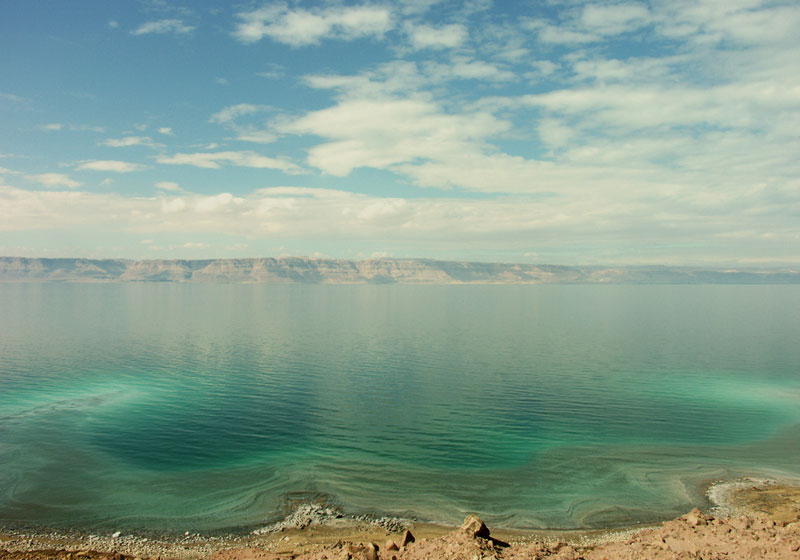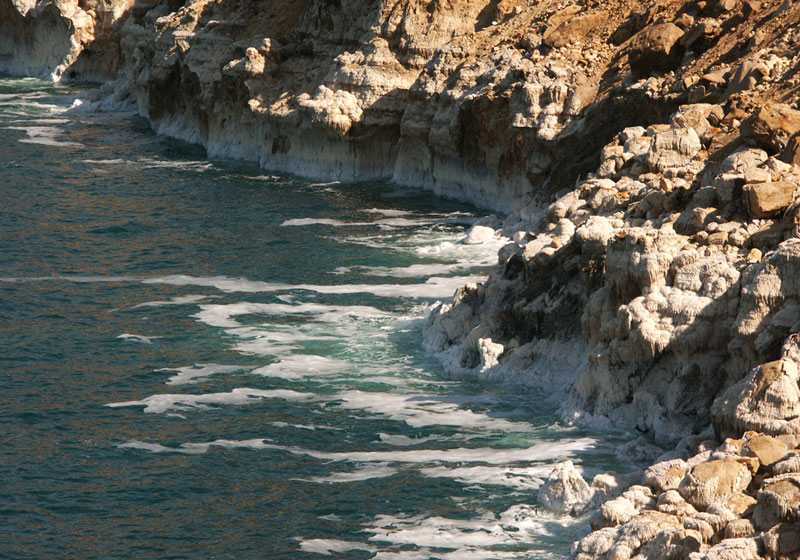The Rich Receding Lake
The Dead Sea is a unique feature of planet Earth. Between this area of Jordan and Mount Everest in the Himalayas, lies the rest of the world. When you submerge yourself up to the neck in this unusual inland body of water, which is therefore geographically considered a lake, you are at the lowest point on Earth – 416 meters below the shores of the Mediterranean.

Each time one swims in this sea a new personal record of lowness is broken. Return a year later and you have to imagine your last swim as suspended at an imaginary layer above the current water surface. The Dead Sea is like a big swimming pool being emptied, one should quickly enjoy the remaining water, keeping in mind that each swim is unique and each beach is only in its location –once.
This lake is running away –downward- and leaving us, leaving the hotels, the roads, and the surrounding hills behind, unable to catch up with it. For thousands of years, the Dead Sea has been dying. Its water is receding and becoming saltier, and for the past 50 years, the speed at which its level has been dropping is alarming. As most of the Jordan River's water is used for irrigation and domestic purposes, and the country's dams deprive it from being replenished by lesser vital tributaries, the Dead Sea is now at a dying rate of about one meter a year. This means that if you visit it once a week, each time you swim, the sea will be some 2cm lower.
Historically, the water level was as high as the base of the bridge at the Mujib gorge, minus 390m. In fact, photos taken as recently as the 1930s show the Mujib gorge visited by boats. If one of these boats would have tied its ropes at any point along those now vanished shores of the 1930s, today it would be hanging on the mountainside about one kilometer away from the sea and some 20 meters above its water.
The Dead Sea wasn’t always dead. About 20 thousand years ago it covered 160km of the length of the Jordan Valley, forming the “Lisan Lake” that reached from a point 40km south of the current Lisan and all the way to Lake Tiberius. The Dead Sea’s history also seems to repeat itself, for its current shape –basically limited to the northern part without the southern part that usually appears on maps– seams to have been formed before. The 1500-year-old mosaic map of Madaba, ironically, reflects a closer resemblance of the sea’s current shape than most of the "modern" maps of today. The low level during the Byzantine era (5th century AD) may hint to a long period of drought, maybe due to a cycle of hundreds or thousands of years. It also corresponds to the story of Sodom and Gomorrah, which seem to have been flooded in the filling-up process.
The banks of this lake are moving. In fact, the Jordanian side is traveling north in relation to banks on the western side. Each year Jordan, Madaba, and the Dead Sea hotels move few millimeters to the north, if this journey continues, in 30 million years these hotels will be facing Nazareth.
In Geological terms the Dead Sea is relatively young. As part of some geological event in the Rift valley and the Red Sea, it is only some 27 million years old. When the Dead Sea was being formed, Dinosaurs had already been extinct and fossilized for some 35 million years.

This dying lake and the rest of the Jordan valley provide us with a unique opportunity to view a dramatic vertical cut in the depths of Jordan's landscape –a cross-section in time that resembles the pages of an open book; a rare manuscript that we must learn to read, and pass to our children in a legible condition.
A half or full day destination. Refreshing and rejuvenating, even in mid-summer, around sunset when brisk winds add to the experience. A visit can be combined with a meal at one of the smart restaurants in the nearby hotels. Bring enough water, some towels and a swimming suit. Only suitable for older children who should remain under close supervision. Careful not to get the water in your eyes as it really stings. If you do, rinse immediately with plenty of fresh water.